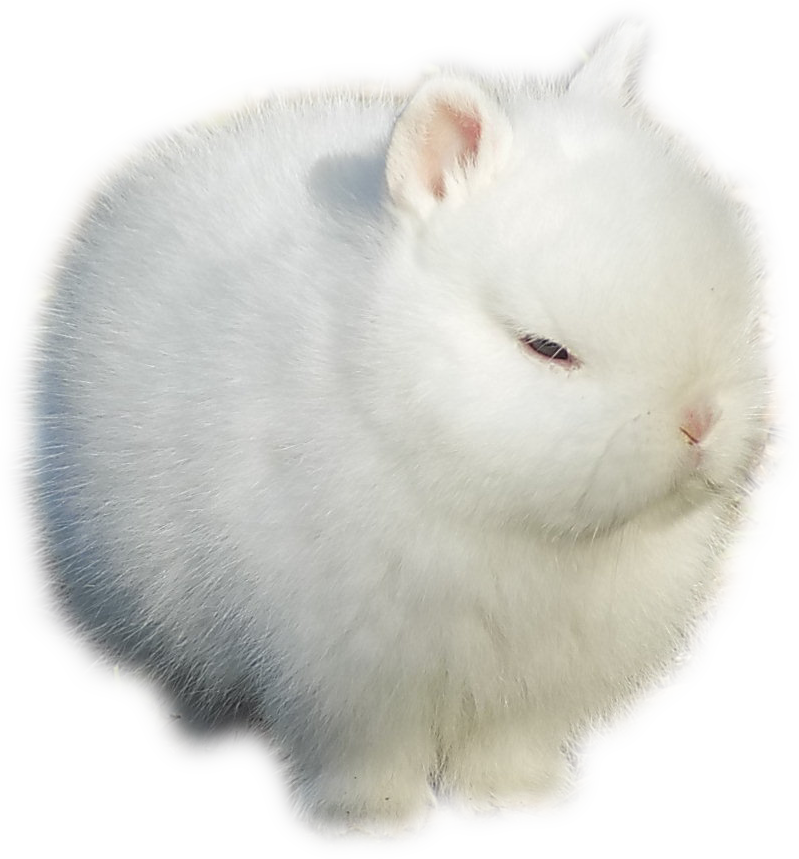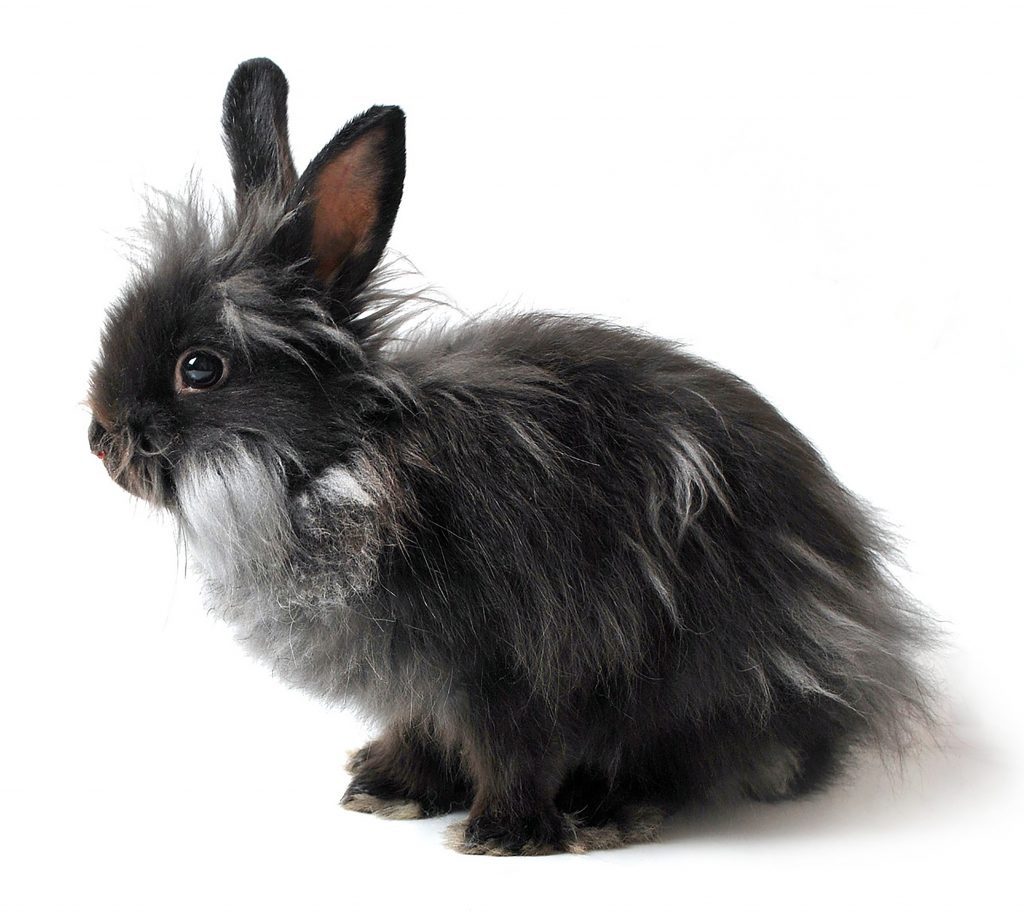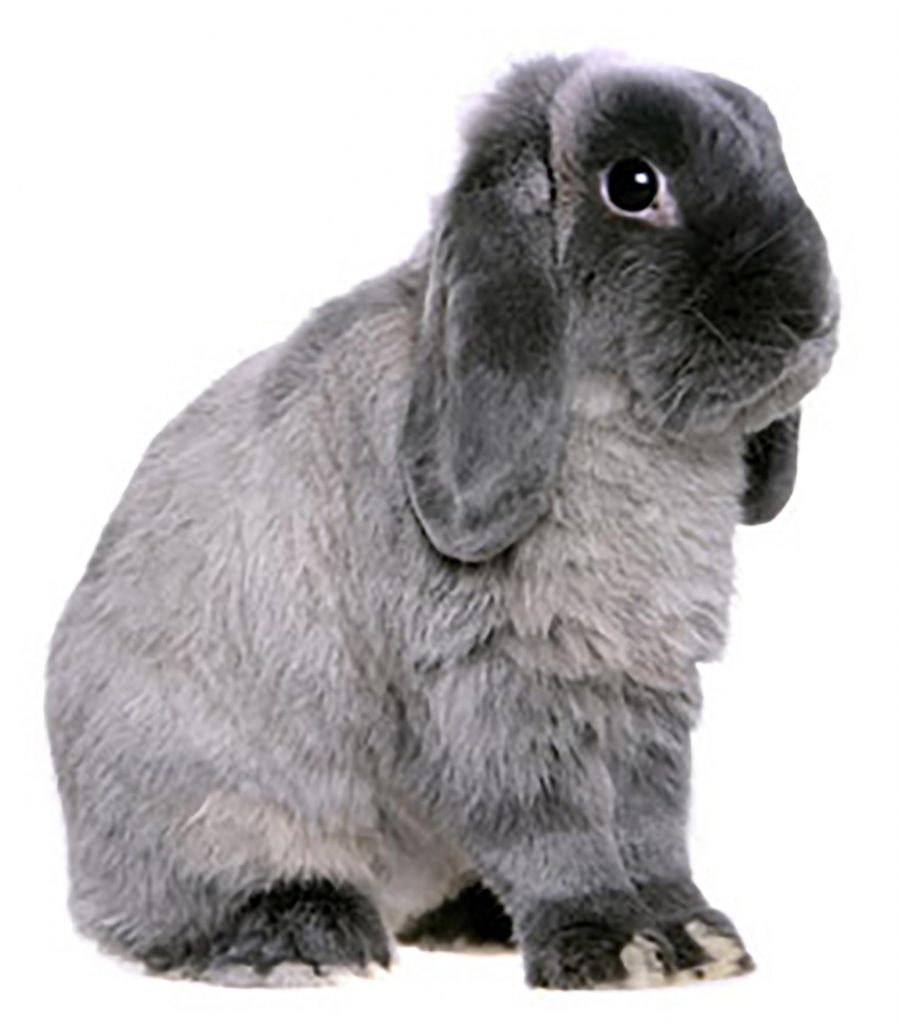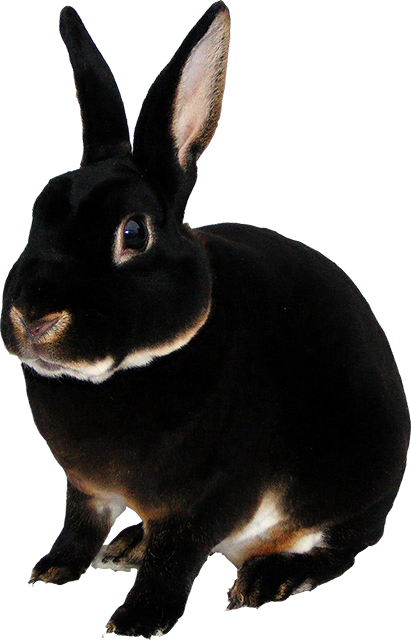

Dwarf rabbit breeds
Even dwarf rabbits, like other animals, can vary by breed and type. If you have just adopted a bunny or are thinking of getting one, here are some profiles with photos and characteristics of each breed. Have fun discovering the differences and curiosities that distinguish them!
Netherland Dwarf rabbit
Size: 0.7 – 1.1 kg
Color: various colors and patterns.
Body shape: round and compact.
Ears: short and erect.
Anatomy: the head and eyes of the colored dwarf rabbit are slightly wider than other breeds and slightly disproportionate to the body. The ears are short and erect and the head is round. In terms of size, it is very similar to the Polish dwarf rabbit. These characteristics make it look like a puppy even when it has reached adulthood.
Coat: the coat varies greatly depending on the nature and origins of the rabbit. So not only the color but also the shine and length can vary greatly.
Lifespan: the average lifespan of a colored dwarf rabbit is around 10 years. Much depends on the environment in which the rabbit grows and the care it receives. Some specimens even exceed 10 years.
Personality: being a breed born from the crossbreeding with a wild dwarf rabbit, the response of each specimen to care and domestic attention is individual. Today it can be said to be one of the most common dwarf rabbit breeds in our homes and its character is quite docile and sociable. Being active and exuberant, however, it needs to live freely around the house and be able to exercise constantly.
Health: the colored dwarf rabbit, being a small animal with a not robust bone structure, requires maximum attention and careful care. The advice is to constantly monitor the diet and dental health.
History: the colored dwarf rabbit was born at the beginning of the 1900s from a crossbreeding between a Polish dwarf rabbit and a type of wild dwarf rabbits. After many generations, what resulted from the crossbreeding of these two breeds is the colored dwarf rabbit as we know it, in all its numerous variations. The first arrival in Great Britain from Holland dates back to 1948 and in America to the mid-1960s. Periods in which it was accepted by the two major breeders’ associations in both countries. What characterized the first specimens was an aggressive temperament, caused by the crossbreeding with the wild rabbit. Something that is no longer the case today.


Jersey Wooly Rabbit
Size: 0.7 – 1 kg
Color: white with red or blue eyes. But also present in other colors
Body shape: less rounded than other breeds
Ears: short and erect
Anatomy: the most relevant characteristics of its body are the very small and erect ears and the body shape which is less rounded than other breeds. Due to its small size, the Polish dwarf rabbit is often confused with the colored dwarf rabbit. What distinguishes them clearly, however, is the shape of the head, which is much less round in the Polish rabbit. But there are also other small differences in color and coat type. The quintessential color of the Polish rabbit is white with blue or red eyes. When red eyes are present, it can be defined as albino, while with blue eyes the dominant gene is different, so it is not defined as albino.
Coat: the official color of the Polish dwarf rabbit is white, but since the 1950s, other colors have also been introduced. Usually, these are dark colors: chocolate or black.
Lifespan: about 6 years, but there are cases where it can reach up to 10 years of age.
Personality: given its small size, it is a perfect breed for apartments. It is usually sociable and calm. The male specimen can become aggressive if not neutered due to strong territoriality. It does not like living with children because being small, it is not able to handle the stress caused by loud noises or sudden movements.
Health: it does not suffer from particular health problems attributable to the breed. However, it is always important to check the teeth, diet, ears, and fur to prevent the most common causes of illness. The short hair should be brushed during shedding periods.
History: the Polish dwarf rabbit is one of the oldest breeds. And despite what one might imagine, it is not originally from Poland, but from England. Although today the name changes in different regions of the world. The name used in Italy, “Polacco,” has its origins in English. In fact, at the end of the 19th century, a group of English breeders came into contact with this crossbreed and perhaps due to the white color of the coat, decided to call the breed “Polish.” The origins of the crossbreed seem to date back to 1600 due to the union of a Himalayan and a Dutch rabbit. For decades, they were not used as pets, especially in some countries such as Belgium, and only since the 1900s, have they been present in our homes and in those of Americans.


Lionhead rabbit
Size: 1.3 – 1.7 kg
Color: various colors and patterns. The most common are black, blue, beige, and pearl white. The eyes of white individuals are usually blue or red.
Body shape: round
Ears: erect, usually not exceeding 7.5 cm in length.
Anatomy: The Lionhead rabbit has a small, short, and compact body. The shoulders and chest are wide and well-proportioned. The head should be rich in long hair with some distance between the two eyes and a well-pronounced muzzle. The neck should not be visible when sitting. The hind legs are wide and well-rounded. The legs are of medium length and not too thin.
Coat: The coat is of medium length and dense along the back, and some individuals have particularly woolly and soft hair on the hips. The Lionhead rabbit gets its name from the strong resemblance of the hair on its head to a lion’s mane. It forms a circle around the head and ends with tufts near the ears. However, not all Lionhead rabbits maintain a thick mane over time.
Lifespan: The average lifespan of a Lionhead rabbit is about 7-9 years. But like all domestic animals, this depends on care and especially diet.
Personality: Being a relatively new breed, general considerations cannot always be made. It depends a lot on the type, crossbreed, and character of the parents. In general, however, they have a playful nature and are very sociable.
Health: The long and woolly fur requires constant brushing, especially from when they are young, so at least once a week. During intense shedding periods, brushing can and should occur once a day. However, as they reach adulthood, this can decrease. I suggest feeding them, without exaggerating in quantity, pineapple, preferring it to other types of fruit because it allows for the reduction of hair knots, making it easier to comb and reducing the risk of gastrointestinal stasis.
History: The Lionhead breed first appeared in the 1960s in both France and Belgium. Breeders in both countries were trying to breed a long-haired dwarf rabbit. In Belgium, they succeeded thanks to a cross between a Belgian dwarf and a rare breed called the Swiss Fox. In reality, it is still not known today how this crossbreed actually came about, as some consider it a mix between an Angora rabbit and a Swiss Fox. Naturally, the success of the crossbreed is due to the fact that long hair is a dominant gene for these two breeds.


Mini Lop rabbit
Size: 2 – 2.2 kg
Color: various colors and patterns. So far, 84 colors have been recognized.
Body shape: short and stocky
Ears: low
Anatomy: The Dwarf Lop should have strong muscles and a well-balanced body structure in length and height. Generally, the body is short and stocky. The width of the shoulders should be equal and not greater than that of the hind legs, and the chest should be wide. Finally, the hind legs should be round and wide. Female specimens may have a slight double chin.
Coat: The coat is shiny, dense, and uniform in length. The fur should not exceed 2.5 cm in length and be parallel to the body.
Lifespan: Contrary to popular belief, the average lifespan of a Dwarf Lop can now exceed ten years. Although they are fragile specimens, if well cared for and welcomed into the home, they are among the longest-lived.
Personality: Personality depends a lot on the individual. But, in general, they are docile rabbits with a good and sociable temperament. They are intelligent, and it is easy to train them to use the litter box. In our homes, they are among the most common, particularly because they seem to be the most suitable for children who must still know how to take care of them and not disturb or attack them. There are few differences in character between a male and a female, although the male, if neutered, is considered more docile and affectionate, but much depends on the individual.
Health: Like other breeds, daily care and attention are essential. The Dwarf Lop, in particular, will need weekly brushing that can become daily during molting periods (autumn and spring). As for the most common diseases, it is essential to sterilize and vaccinate your rabbit, and pay particular attention to eating habits and low ears with constant checks from you and visits to the vet.
History: The Dwarf Lop is the smallest breed of Lop rabbit. The first breeder to create this breed was Adrian De Cock, whose goal was to create a mini version of the French Lop. The first pairings started in 1949, but they did not produce the expected results because, due to some dominant genes, typical French Lop characteristics such as low ears did not appear in the new puppies. But after finding the correct male and female cross and after several attempts, De Cock succeeded in reaching the Dwarf Lop as we know it today, and in 1964 the breed was officially recognized. It is now one of the most popular breeds in our homes, and you will have no difficulty finding an association for adoption or breeding in your area.
This breed, among the most common, was developed in the Netherlands around the 1950s. It derives from the French Lop rabbit, whose specimens can weigh up to 4.5 kg. The Lop rabbit was first recognized as a breed by the British Rabbit Council in 1976.


Dutch Dwarf rabbit
Size: 2 – 2.2 kg
Colors: black, blue, chocolate, beige, gray, tortoiseshell
Body shape: round
Ears: upright
Anatomy: The Dutch Dwarf rabbit is usually characterized by a round and compact body and a similarly round head. The ears are short, robust, and upright. The hind legs are very powerful and longer than the front legs.
Coat: The coat is fairly short and often shiny and soft. The characteristic colors are white and black, but it can also appear in blue, chocolate, or gray in dark areas. The spots are symmetrical and it is characterized by an inverted V on the muzzle.
Personality: Present in European households for centuries, the Dutch Dwarf rabbit is known to be sociable and playful, but also gentle and affectionate. Compared to other breeds, it is suitable for the company of a child who must, however, always be educated or supervised. Being an intelligent breed, it will not be difficult to train it to respond to its name or other specific movements. However, it should always be remembered that being playful, it can easily get bored and should therefore be indulged in its request for time and attention.
Health: The most common health problem for the Dutch Dwarf rabbit is related to its teeth. The advice in this case is to constantly monitor its diet and consumption of incisors and molars to prevent the onset of problems, sometimes fatal.
History: Contrary to what one might imagine from its name, the Dutch Dwarf rabbit was not born in Holland but in the United Kingdom. The story goes that some specimens of a very similar breed arrived in England in the nineteenth century from Belgium as non-pet animals. These were known as Petit Brabançon and actually appear in various paintings from the fifteenth century. Upon arriving in England, some specimens were saved by a breeder who tried to modify their gene until he obtained a rabbit characterized by the colors white and black, but also by the typical inverted V around the muzzle. For more than a century, the Dutch Dwarf rabbit was the most common pet in European households and still remains one of the most sought after, despite being joined by younger breeds.


Mini Rex
Size: 1.7 – 2 kg
Color: various colors and patterns. The most common are: amber, black, blue, beaver, chocolate, white, and lynx.
Body shape: round (commercial)
Ears: upright
Anatomy: the Rex rabbit has a slightly larger head compared to other dwarf rabbit breeds. It has upright and well-proportioned ears, as well as sharp nails of the same color as its fur. The legs are slightly smaller and disproportionate to the body. Like several other species, the female is characterized by a pronounced double chin.
Coat: its fur is usually described as velvety, and its length ranges from 1.3 to 2.2 cm. The coat is dense and soft because it is very short and grows perpendicular to the skin. During the shedding period, the fur may slightly curl, especially in areas where it is longer, such as behind the ears. Moreover, shedding can cause a change in the whiskers, which can curl and become shorter or even decrease to the point of not seeming to exist.
Lifespan: the average lifespan of a Mini Rex rabbit is lower compared to that of other breeds, as it ranges around 5-6 years. However, there is no doubt that sterilization can extend it up to about 8-11 years, as already happened in some cases.
Personality: Rex rabbits are known to be one of the most intelligent breeds and easily litter box trained. A Rex rabbit can also be trained to perform simple commands such as being called to be followed or standing on two legs or jumping over an obstacle. In any case, the rabbit must be rewarded for being well-behaved. This breed has a moderate need for exercise, and a specimen can jump up to 90 cm. Like other breeds, Rex is more predisposed to move at night and less during the day. As they are among the most docile and intelligent breeds, they are recommended for families with children, provided that they are well educated in living with a rabbit.
Health: some Rex specimens are more prone to sore throats. In addition, a diet with a low percentage of protein is advisable during shedding as it could prolong it.
History: Rex rabbits are a species originating from France at the beginning of the twentieth century, to be precise, the first specimen dates back to 1919. Since the Mini size was introduced, the term Rex refers to the medium-sized type.


Himalaya
Size: 1-2 kg
Color: white with black, brown or blue spots on the feet, nose, and ears. Eyes are red or pink.
Body shape: cylindrical, slender and long
Ears: erect
Anatomy: The Himalayan Dwarf rabbit has a slender and elongated body. The breed is classified as cylindrical, given that the body, when in a stretched position, resembles the shape of a tube. The main characteristic is related to the color of the nose, feet, and tail. As one of the oldest and most natural breeds, the Himalayan is not the result of a modern cross. The history is uncertain, but the physical characteristics are clear: besides the spots, red eyes are another constant of the breed. The hips are the same width as the shoulders, and the legs are long and tapered. The head is also slender, with erect ears. The nails, like the extremities of the feet, should be dark. In reality, at birth, Himalayan Dwarf rabbits are completely white. They develop their typical coloring in the terminal areas of the body around 4 weeks of age and reach complete coloring at around 6 months old.
Coat: The coat is always white or pearly, except for the dark-colored extremities of the body: ears, nose, feet, and tail. The distinctive markings of the Himalayan Dwarf rabbit’s coat are related to a recessive gene (opposite of the dominant) developed over the centuries and linked to the decrease in blood circulation in the extremities of the body.
Personality: The Himalayan Dwarf rabbit is known to be calm, sociable, and intelligent. If accustomed to sharing everyday life and not kept in a cage, they can be among the most affectionate and sociable, becoming an integral part of the family. They appreciate attention and time spent playing, but they also need plenty of space to run. If kept indoors, it is advisable to give them the opportunity to go out on the balcony during the intermediate periods of spring and autumn when there is neither excessive heat nor cold. Among all the breeds, it seems to be the most sociable, so it is not excluded the possibility of adopting a playmate if both are sterilized.
Health: In general, there are no particular diseases related to the breed. However, it is always necessary to control their diet to avoid intestinal problems, teeth problems, and possible viruses or overweight. It is important to spay or neuter the Himalayan Dwarf rabbit in the house to prevent territorial marking with urine or feces, especially female specimens as they can develop uterine cancer.
History: The Himalayan breed is one of the oldest in the world. It has been present in human history for centuries under numerous names: Egyptian, Russian, Chinese, or black-nosed. The breed as we know it today, however, has been present in England since the mid-19th century when it was brought by explorers and adventurers from Asia. It then spread to the rest of Europe. But it is since the mid-twentieth century that the breed has also been present in America. The Himalayan breed is one of the oldest in the world. This small, often lean rabbit has distinctive characteristic markings. The breed is classified as cylindrical, given that the body, when in a stretched position, resembles the shape of a tube. The coat is mostly white, but the ears, nose, tail, and feet can be blue, black, or chocolate brown. They are born white with spots that develop with growth, and their eyes can be red or pink.


Mini Angora rabbit
Size: 1.2 – 1.5 kg
Color: White
Body shape: Round
Ears: Upright
Anatomy: The Angora dwarf rabbit is a particularly small rabbit, weighing a maximum of about 1.5 kg in adulthood and good health. Its body is round, short, and compact. The ears are upright and the eyes shiny and deep. The main characteristic of this breed is its coat.
Coat: It is estimated that the hair growth of this breed is three times higher than that of other dwarf rabbits. In fact, it takes three months to grow the fur as opposed to one month for other dwarf rabbits. Due to its long and soft fur, this breed requires more attention than any other. The fur can be of numerous variations of solid color or sometimes spotted. The length of an adult specimen is around 5-7 cm.
Lifespan: The lifespan of an Angora dwarf rabbit can vary greatly depending on living conditions and care, ranging from 6 to 10 years of age.
Personality: The dwarf rabbit is known for its small size and calm disposition, which make it an excellent pet to keep indoors. Being a calm and sociable animal, it is ideal if there are other rabbits, dogs, cats, or guinea pigs in the house. As with other breeds, sterilization is preferable to maintain the rabbit’s calm nature and prevent the development of aggression or territoriality.
Health: Naturally, the most important physical characteristic of the Angora dwarf rabbit is its coat, which is also its biggest problem. If not brushed regularly and cared for during shedding periods, the rabbit’s fur can be ingested and cause intestinal blockages. Moreover, being very long, it will be more difficult to identify flea bites or other insect bites, so regular checks during brushing are the best preventive measure.
History: The Angora rabbit has been well-known since ancient times, but the dwarf version is actually very recent. Born from a cross between the dwarf rabbit and the French Angora, it was only recognized at the end of the 1980s, despite being present in Europe and especially in America since the 1970s. The story goes that the breed was originally developed in New Jersey, possibly partly from another characteristic breed of the area: the Jersey Wooly.


Dwarf Hot Hot
Size: 1-1.3 kg
Color: white with black eye outline. Since 2006, white variants with chocolate-colored eye outlines have also been introduced.
Body shape: compact and round
Ears: very short and upright
Anatomy: unlike other breeds it resembles in physical characteristics and size, such as the Polish rabbit, the Hothot dwarf rabbit has shoulders that are wider than its hips. The head is small and round but pronounced. The very short ears are erect. A typical characteristic of the breed is the dark-colored hair around the eyes. Ideally, the two circles around the eyes should be the same size and both black or chocolate brown in color.
Coat: the Hothot breed is characterized by an elegant white short-haired coat, but above all by a always black eye contour. This makes rabbits of this type look like they are always wearing eyeliner, ready for a romantic encounter.
Personality: the mood of this rabbit breed can vary. It is indeed a docile specimen, but also temperamental. If raised in a quiet and well-kept home environment, the Hothot dwarf rabbit can be an excellent playmate for games and adventures. As with others, personality depends a lot on the rabbit and the love and attention given to it.
Health: unlike others, this breed does not have particular problems related to its anatomy or personality. Regular dental check-ups, a balanced diet, and a family environment will certainly make it a great friend and playmate.
History: the Hothot dwarf rabbit breed as we know it today was born in Germany in the 1970s. The story is funny and tells of two breeders, one from East Germany and the other from West Germany, who independently began studying for the creation of this breed. One crossed a Dutch dwarf with a non-dwarf Hothot, while the other crossed a Dutch rabbit with a dwarf. The result was that the two had to join forces to finally create the Hothot dwarf rabbit. However, the breed was only recognized in the mid-1980s.


